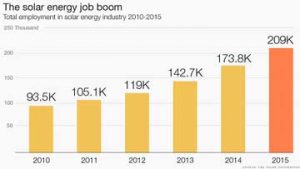Presently solar energy is getting popular in the entire world and its use can enhance by 40 percent in next 5-year. Experts analyzed that Pakistan is best placed to utilize solar energy in meeting energy shortfalls, balance energy mix and decline reliance of imported fuel. The nation require similar zeal as expressed in attaining nuclear energy as domestic oil & gas extraction has not progressed while pace of progress on Thar coal is far from acceptable.

In the country, oil import bill has become unsustainable, which calls for instant action on all the fronts with solar energy on the major of all power projects. No doubt sun is a source of clean, sustainable and infinite power with no chance of any disruption like political problems, volatility in oil market and conspiracies of the enemy states.
Our energy mix, with a heavy dependence on expensive imported fuels, has deteriorated over the previous two-decade damaging forex reserves. Hence, cleaner, quicker and natural solar energy would be a great addition to the existing energy mix.
Experts also calculated that sunlight was the most luxurious source of energy generation and cost of generating 1.0 unit of electricity by solar power was Rs22.81, whereas energy generation by hydel source only cost Rs1.78. The energy generation by gas cost Rs7.97, nuclear Rs8.33, import from Iran Rs10.49, furnace oil Rs11.74, bagasse Rs11.78, coal Rs12.06, wind Rs14.31 while energy generation by high speed diesel cost Rs18.61.
The Ministry of Water and Power has completed under construction projects on war-footing and tapped/identified many resources which included solar energy projects in Lal Sohanra, wind power projects in Sindh and coal and nuclear based energy plant at Thar, Sindh, Sahiwal and costal region of Karachi. It is also said that per unit cost of energy had been risen from Rs4.25 in 2007 to Rs11.40 during 2016. Furthermore in 2007 Nepra determined cost of 1.0 unit of power was Rs5.31, whereas the Government of Pakistan determined tariff was Rs4.25. The Nepra tariff escalated to Rs9.57 in 2010, whereas the government determined tariff was Rs7.29. During June 2015 the Nepra notified energy price went up to Rs12.33, whereas the current government notified tariff was Rs11.40.
Construction works on the Neelum-Jhelum Hydropower Project was in full swing; however, no energy was being produced from the project. It was predicted to start generation by July/August 2017.
The Government of Pakistan had levied Neelum-Jhelum surcharge on power consumers except K-Electric to meet part of the financing requirements of the project, which was almost 11 percent of the project cost.
The federal government had not received any offer from China for construction of small dams on various rivers of KPK and Punjab to produce energy.

Experts said feasibility study of 4,000MW Thakot Hydropower Project had been started during January 2016, which will take 2-year in completion. Presently the Government of Punjab has proclaimed to shift as many as 5000 schools on solar power. Punjab government is ardently working on dissimilar projects to promote solar power as Pakistan is facing disastrous energy related challenges. It’s the need of era to use solar power for the elimination of electricity shortfalls.
 PAGE Blog Business Weekly Magazine
PAGE Blog Business Weekly Magazine

